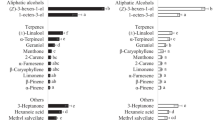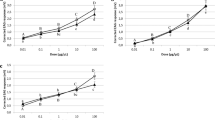Abstract
Twenty-six compounds have been identified from fresh orange airborne volatiles, the most abundant being limonene and alloaromadendrene. Ethyl- and butylhexanoates were found in middle concentrations, whereas the other compounds occur at low levels. Electroantennograms recorded fromCeratitis capitata Wied. (males and females) revealed limonene. butyl hexanoate, dihydrocarvone, and limonene oxide to be most active. In the case of dihydrocarvone, 4-ethyl acetophenone, and carvone, female antennae give greater responses than antennae of males. Limonene oxide was more active for males than females. Total airborne volatiles recovered from oranges elicited high EAGs, with females being more sensitive than males.
Similar content being viewed by others
References
Anonymous. 1991. Eight Peak Index of Mass Spectra. The Royal Society of Chemistry, Cambridge.
Binder, R. G., Benson, M. E., andFlath, R. A. 1990. Volatile components of safflower.J. Agric. Food Chem. 38:1245–1248.
Claude-Lafontaine, A., Rouillard, M., Cassan, J., andAzzaro, M. 1976. Composés terpéniques inédits constituants de l'huile essentielle de cascarille.Bull. Soc. Chim. 1:88–90.
Connolly, J. A., andHill, R. A. 1991. Dictionary of Terpenoids. Chapman & Hall, London.
De Pascual Teresa, J., Urones, J. G., andFernandez, A. 1983. Monoterpene derivates from the essential oil ofAristolochia longa.Phytochemislry 22:2753–2754.
Dickens, J. C., Jang, E. B., Light, D. M., andAlford, A. R. 1990. Enhancement of insect pheromone responses by green leaf volatiles.Naturwissenschaften 77:29–31.
Dixon, W. J. 1992. Statistical Software Manual. University of California Press, Davis.
Doyle, P., Maclean, I. R., Murray, R. D. H., Parker, W., andRaphael, R. A. 1965. Bridged ring system. Part VI. The total synthesis of (±)-clovene.J. Chem. Soc. 1965:1344–1351.
Flath, R. A., Light, D. M., Jang, E. B., Mon, T. R., andJohn, J. O. 1990. Headspace examination of volatile emissions from ripening papaya (Carica papaya L., solo variety).J. Agric. Food Chem. 38:1060–1063.
Fornasiero, U., Guiotto, A., Caporale, G., Baccichetti, F., andMusajo, L. 1969. Identificazione della sostanza attrattiva per i maschi dellaCeratitis capitata, contenunuta nell'olio essenziale dei semi diAngelica archangelica.Gazz. Chim. Ital. 99:700–710.
Guerin, P. M., Remund, U., Boller, E. F., Del Rio, G., andKatsoyannos, B. 1983. Fruit fly electroantennogram and behaviour responses to some generally occurring fruit volatiles, pp. 248–251,in R. Cavalloro (ed.). Fruit Flies of Economic Importance. A. A. Balkema, Rotterdam.
Hippe, C. 1987. Responses of laboratory strains ofCeratitis capitata flies to their ovipositiondeterring pheromone, pp. 149–150,in R. Cavalloro (ed.). Fruit Flies of Economic Importance. A. A. Balkema, Rotterdam.
Jacobson, M., Uebel, E. C., andLusbey, W. R. 1984. Essential oil yields medfly attractant.Chem. Eng. News 17:22.
Jang, E. B., Light, D. M., Flath, R. A., Nagata, J. T., andMon, T. R. 1989. Electroantennogram responses of the Mediterranean fruit fly,Ceratitis capitata to identified volatile constituents from calling males.Entomol. Exp. Appl. 50:7–19.
Kendall, M., andStuart, A. 1976. The Advanced Theory of Statistics, Vol. III, Design and Analysis and Time-Series. Charles Griffin, London.
Knudsen, J. T., Tollsten, L., andBergström, L. G. 1993. Floral scents—checklist of volatile compounds isolated by head-space techniques.Phytochemistry 33:253–280.
Levinson, H. Z., Levinson, A. R., andMüller, K. 1990. Influence of some olfactory and optical properties of fruits on host location by the Mediterranean fruit fly (Ceratitis capitata Wied.).J. Appl. Entomol. 109:44–54.
Levinson, H. Z., Levinson, A. R., andSchäfer, K. 1987. New aspects of the pheromone biology of the Mediterranean fruit fly, pp. 113–128,in R. Cavalloro (ed.). Fruit Flies of Economic Importance. A. A. Balkema, Rotterdam.
Light, D. M., Jang, E. B., andDickens, J. C. 1988. Electroantennogram responses of the Mediterranean fruit fly,Ceratitis capitata, to a spectrum of plant volatiles.J. Chem. Ecol. 14:159–180.
Light, D. M., Jang, E. B., andFlath, R. A. 1992. Electroantennogram responses of the Mediterranean fruit fly,Ceratitis capitata, to the volatile constituents of nectarines.Entomol. Exp. Appl. 63:13–26.
Mateo, C., Sanz, J., andCalderon, J. 1983. Essential oil ofSideritis hirsuta.Phytochemistry 22:171–173.
MacLeod, A. J., MacLeod, G., andSubramanian, G. 1988. Volatile aroma constituents of orange.Phytochemistry 27:2185–2188.
Pakrashi, S. C., Ghosh Dastidar, P. P., Chakrabarty. S., andAchari, B. 1980. (125)9-7,12-Secoishwaran-12-ol, a new type of sesquiterpene fromAristolochia indica Linn.J. Org. Chem. 45:4765–4767.
Prokopy, R. J., andRoitberg, B. D. 1984. Foraging behavior of the true fruit flies.Am. Sci. 72:41–49.
Schreier, P., Drawert, F., Junker, A., andMick, W. 1977. Über die quantitative Zusammensetzung natürlicher und technologisch veränderter aromen.Z. Lebensm. Unters.-Forsch. 164:188–193.
Shelly, T. E., Whittier, T. S., andKaneshiro, K. Y. 1993. Behavioral responses of Mediterranean fruit flies (Diptera: Tephritidae) to trimedlure baits: Can leks be created artifically?Ann. Entomol. Soc. Am. 86:341–351.
Stenhagen, E., Abrahamsson, S., andMcLafferty. F. W. 1974. Registry of Mass Spectral Data. John Wiley & Sons, New York.
Sugisawa, H., Yamamoto, M., Tamura, H., andTakagi, N. 1989. The comparison of volatile components in peel oil from four species of navel orange.Nippon Shokuhin Kogyo Gakkaishi 36:455–462.
Tamura, H., Yang, R. H., andSugisawa, H. 1993. Aroma profiles of peel oils of acid citrus, pp. 121–136,in R. Teranishi, R. G. Buttery, and H. Sugisawa (eds). Bioactive Volatile Compounds from Plants. American Chemical Society, Washington, DC.
Tang, J., Zhang, Y., Hartman, T. G., Rosen, R. T., andHo, C. T. 1990. Free and glycosidically bound volatile compounds in fresh celery (Apium graveolens L.).J. Agric. Food Chem. 38:1937–1940.
Teranishi, R., Buttery, R. G., Matsumoto, K. E., Stern, D. J., Cunningham, R. T., andGolthilf, S. 1987. Recent Developments in chemical attractants for tephritid fruit fly.ACS Symp. Ser. 330:431–438.
Warthen, J. D., Jr., andMcInnis, D. O. 1989. Isolation and identification of male medfly attractive components inLitchi chinensis stems andFicus spp. stem exudates.J. Chem. Ecol. 15:1931–1946.
Author information
Authors and Affiliations
Rights and permissions
About this article
Cite this article
Hernández, M.M., Sanz, I., Adelantado, M. et al. Electroantennogram activity from antennae ofCeratitis capitata (Wied.) to fresh orange airborne volatiles. J Chem Ecol 22, 1607–1619 (1996). https://doi.org/10.1007/BF02272401
Received:
Accepted:
Issue Date:
DOI: https://doi.org/10.1007/BF02272401




